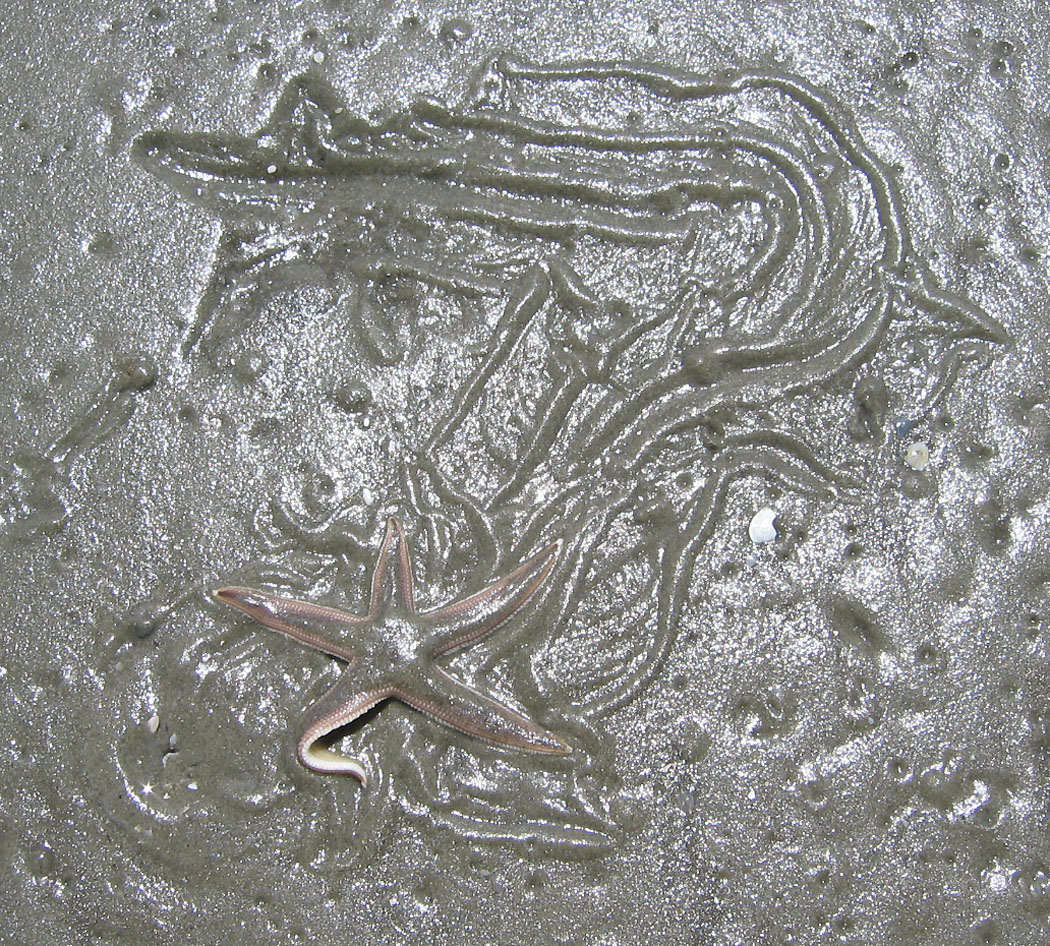The last of my holiday-inspired series of photos depicting traces from the Georgia barrier islands is of one most people will see only rarely, but is a glorious one to spot. It is the trail left by a lined sea star (Luidia clathrata), best observed on the lower parts of sandy beaches.
 A beautifully expressed trail left by a lined sea star (Luidia clathrata). The sea star itself is only about 10 cm (4 in) across, but its trail shows how far it traveled, from its initial “resting” spot to where you see the tracemaker itself. (Photograph by Anthony Martin, taken on Sapelo Island.)
A beautifully expressed trail left by a lined sea star (Luidia clathrata). The sea star itself is only about 10 cm (4 in) across, but its trail shows how far it traveled, from its initial “resting” spot to where you see the tracemaker itself. (Photograph by Anthony Martin, taken on Sapelo Island.)
Sea stars make such trails when stranded on the lower part of a beach by a high tide. Once exposed, especially under a summertime sun, they can either dry out quickly or become easy prey for a wandering seagull. If they’re fortunate enough to be on or otherwise near a saturated sand, they’ll bury themselves by moving their hundreds of tube feet underneath them. This makes a sort of localized quicksand around them, and they will sink into the sand, which normally solves their dual problem of dehydration and predation. However, the resulting trace this makes is a star-shaped bump on the sand surface, which to many seagulls still translates as “food.” Many times I have seen and photographed spots on beaches where a gull was practicing its own form of ichnology, where it walked straight to a buried sea star, plucked it from its temporary resting spot, and took it somewhere else to eat.
In this photo, though, the sea star had an even greater challenge when it was left on a sandflat. It was dumped by a high tide onto a part of the beach with a thin layer of wet sand overlying a more firmly packed sand. This meant that the sea star’s tube feet could only get it so far down into the sand, having been stopped by the hard, packed layer underneath. So its only other choice was to move laterally along the wet sand, which it accomplished through a combination of tube feet and arms, causing it to glide through and on top of the sand.
My interpretation of this behavior is that the sea star was desperately seeking moisture – whether a softer, wetter sand or a submerged area – and that this journey was more likely to ensure its survival than to simply sit and wait for the next tidal cycle. Considering that sea stars have been around for more than 450 million years, I can only assume this behavior worked quite well for at least of few of this species’ ancestors. Thus I would not be surprised at all by the discovery of trace fossils matching the form and intent of the modern traces shown here.
Meanwhile, let’s give thanks for how lucky we are to see them and understand the meaning of these and other traces being made by Georgia-coast animals every day. Each vestige is a lesson in natural history, beckoning us to learn more about the evolutionary processes that led to what we observe now.
Further Information
Luidia clathrata: Lined Sea Star. Encyclopedia of Life.
Links to Previous Posts in This Theme
On the 12th Day of Ichnology, My Island Gave to Me: 12 Snails Grazing
On the 11th Day of Ichnology, My Island Gave to Me: 11 Plovers Probing
On the 10th Day of Ichnology, My Island Gave to Me: 10 Beetles Boring
On the 9th Day of Ichnology, My Island Gave to Me: 9 Molluscans Hiding
On the 8th Day of Ichnology, My Island Gave to Me: 8 Crab Legs Walking
On the 7th Day of Ichnology, My Island Gave to Me: 7 Lizards Looping
On the 6th Day of Ichnology, My Island Gave to Me: 6 Hatchlings Crawling
On the 5th Day of Ichnology, My Island Gave to Me: 5 Bivalves Drilling
On the 4th Day of Ichnology, My Island Gave to Me: 4 ‘Gators Denning
On the 3rd Day of Ichnology, My Island Gave to Me: 3 Ghost Shrimp Pooping
On the 2nd Day of Ichnology, My Island Gave to Me: 2 Otters Running
